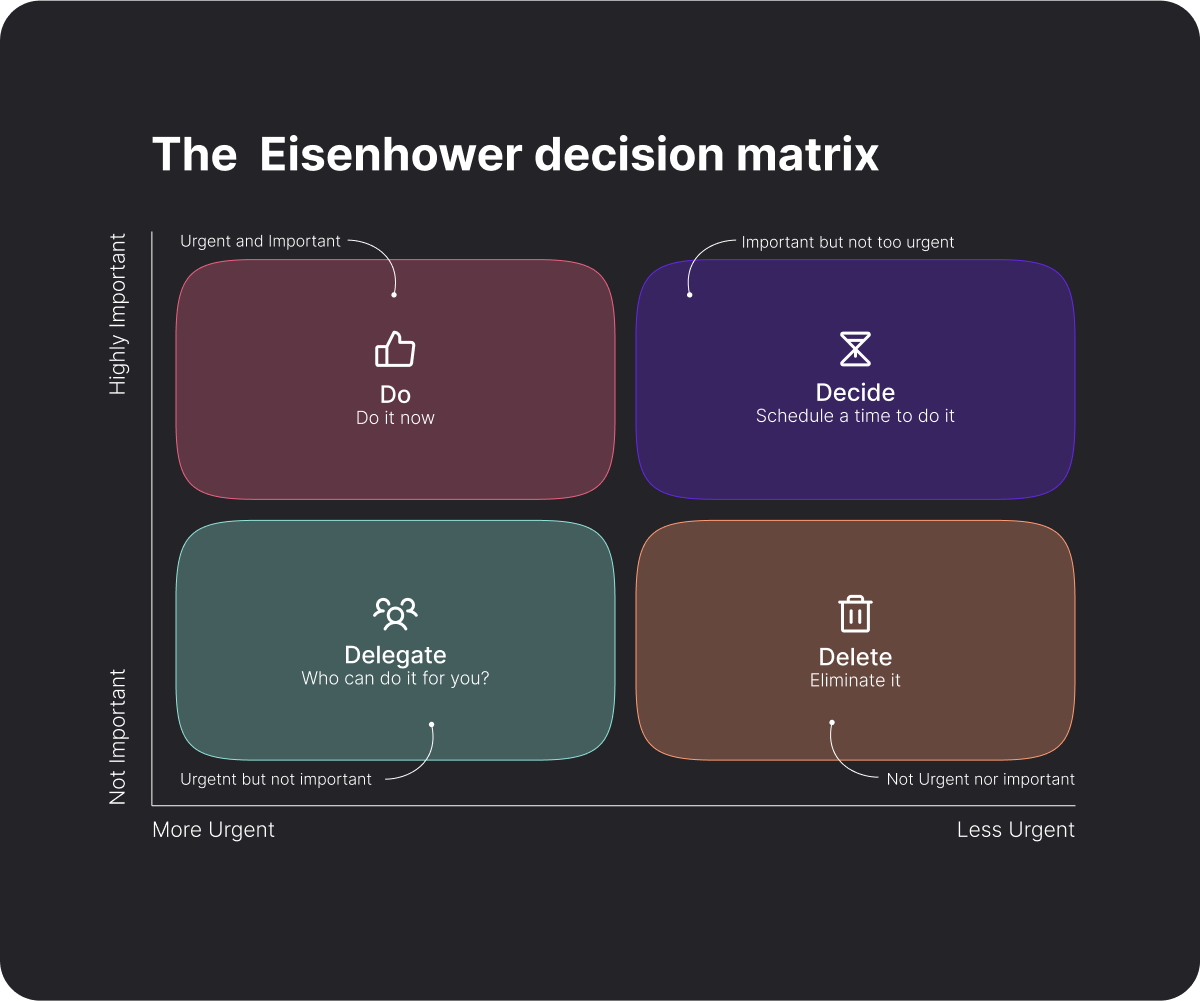Marketing Management Tasks to Prioritize for Successful Results
How can you ensure your marketing efforts are successful? While there’s no guaranteed way, survey data shows that organized marketers are nearly 7x more likely to report success than their peers.
With that in mind, it’s best to approach marketing management – or marketing project management – with an organized list of tasks and appropriately prioritize that list to ensure you’re getting everything done.
In this blog, we’ll walk you through what marketing management is, the tasks that should be on your to-do list, and some strategies to help you best prioritize them. Let’s dive in.
What is marketing management?
Marketing management involves oversight of all marketing-related activities, including branding, campaigns, monitoring, and team management, among other responsibilities.
These tasks are typically spearheaded by the marketing manager who wears many hats within the marketing department. Not only are they responsible for the above, but they’re also responsible for adopting a long-term marketing vision.
At its core, marketing management is essentially project management, which requires managers to have the ability to plan, budget, and track project progress over time – both for campaigns and long-term internal projects and improvements.
Project management and marketing management both require an immense amount of organization, as it’s all too easy for things to slip through the cracks. To help you out, we’ve curated a list of 10 marketing tasks you should prioritize for marketing success.
10 marketing management tasks to prioritize
Nearly every marketing manager oversees campaigns as part of their day-to-day responsibilities. That said, marketing management extends beyond campaign work, and it requires managers to take a look at big-picture marketing activities.
While none of these tasks will come as a surprise, they’re sometimes overlooked amid regular day-to-day activities:
1. Establishing achievable campaign timelines
Campaign management is an undeniable part of marketing management. To set your team up for success, invest time into building a feasible campaign timeline. Consider which previous successful campaigns had a similar timeline that can be replicated versus which past ones were too overly ambitious.
Tip: Check out How to Effectively Manage Marketing Campaigns for everything you need to know about the different types of marketing campaigns and how to execute them.
2. Setting goals and OKRs
Team accountability is an important part of executing projects successfully, and one way to do so is by setting team goals and holding your team responsible for meeting them.
Goal-setting frameworks make it easy to meet expectations and help project managers identify when team members are falling short. There are many different strategies you can adopt for goal setting, such as Objectives and Key Results, SMART goals, or KPIs.
Plus, setting goals increases your odds of achieving them. Nearly 47% of marketers who set goals in 2022 said they achieved them always or most of the time.
3. Testing and developing marketing strategies
Staying in your comfort zone and not testing new marketing strategies can hinder the effectiveness of your campaigns. After all, how can you be sure that you're reaching your target audience to the best of your ability using your current methods?
Sometimes finding the right strategies is a process of trial and error, so developing marketing strategies, testing them, and recording what works is an important task.
This type of testing doesn’t have to be a large financial commitment either. For example, teams who have never used Google ads can try it out while still keeping their ad spend low and seeing what initial marketing insights they get from it.
Also read: Mastering the Art of Digital Marketing Project Management
4. Monitoring marketing campaign performance
Marketing managers are the team leads, meaning they’re typically responsible for tracking team performance. You shouldn’t overlook this task, as proper campaign monitoring is what allows you to course correct should your campaign not be going according to plan.
Marketing teams in particular might struggle to keep track of their budget numbers since many are primarily focused on the creative side of campaigns. As a result, some teams find it easy to accidentally overspend unless someone is constantly monitoring the administrative side of things.

Project management tools like Rodeo Drive can help streamline and automate this marketing task, as these tools are able to bring you real-time insights into your team’s productivity and project performance.
Related: Top 26 Marketing Project Management Software
5. Building customer relationships
While the sales team is in charge of fostering relationships with new leads and closing deals with them, the marketing team plays the vital role of building customer and brand loyalty.
Marketers are often tasked with answering direct messages and comments from customers on social media – an important piece of establishing your brand as reliable and helpful. Anything you can do to improve your relationships with customers is a worthwhile marketing task.

6. Mastering communication
Communication is key in marketing management, whether it includes communicating the value of your good or service to customers or facilitating communication among team members to ensure your campaigns are successful.
On a team level, communication might consist of conflict resolution or scheduling regular team update meetings to keep everyone on the same page. Externally, this will include an emphasis on strategies like public relations and paid advertisements.
After all, marketing is essentially just communicating to customers why they should buy your product, so it’s critical that you communicate your message correctly.

7. Juggling the marketing mix
The marketing mix includes the set of tools used by a firm to execute its marketing objectives. Your marketing mix typically revolves around the 4Ps: product, price, promotion, and place. These four factors determine the course of your marketing campaign.
Every marketing manager should have a clear understanding of how the 4Ps impact their relationship with potential customers, as your customers are the audience for your marketing campaigns.
For example, if your product is priced at a premium, you’ll need to focus your efforts on target customers that are willing to pay a higher price for your product, rather than customers looking for a low-cost solution. The price you’re charging will impact who your customers are and how you’ll reach them.
Also read: How to Create a Winning Marketing Project Plan
8. Improving conversions
The ultimate goal of most activities under marketing management is to turn your audience into paying customers. The nature of your good or service will play a large role in how you can best do so.
For instance, a strong content marketing strategy can result in conversion rates 6x higher than other marketing methods. This is because well-executed blog content helps familiarize your audience with your brand and makes it more likely they’ll try your product once they’re further along in the marketing funnel.
That said, content marketing might only make sense for some types of businesses. This is why a main marketing management task you may want to focus on is finding which channels generate the most marketing qualified leads and focusing your efforts on those. Record your initial baseline conversion rates and see how you can build them over time.
9. Developing your brand
Your brand values should shine through in all of your marketing campaigns to leave your audience with a clear understanding of your brand’s values and beliefs.
You want your potential customers to understand your brand ethos – your values that have the power to evoke emotion in your audience and drive them to act. You want your customers to know about your mission and empathize with it.
In marketing management, brand development requires you to examine how your customers perceive your brand’s strengths and weaknesses. For instance, maybe your mission isn’t compelling enough. You’ll want to rework it to strengthen your brand image.
10. Creating a plan for long-term growth
So your marketing strategies have been working – but what’s your plan to sustain that growth in the long term? Marketers are constantly asking themselves this question.
Every marketing department deploys campaigns, and the successes and failures from each campaign leave your team with key takeaways that inform your future plans. You probably already know that campaigns are short-term marketing efforts with a clear end goal, whereas marketing strategies aren’t time-bound and can impact several campaigns.
And, while marketing activities are separate from product development, marketers are tasked with conducting market research and looking for opportunities to reposition the product to meet the needs of new consumers. Should the marketing team identify opportunities for a new product line, passing along that information to the appropriate team can help foster long-term growth.

Strategies to best prioritize marketing management tasks
As you can see, marketing managers have a variety of different tasks on their plate. This begs the question: how can you best prioritize your marketing management tasks to ensure you get everything done?
From time management to delegation, here’s a look at some strategies to try:
#1 The Eisenhower Matrix
The Eisenhower Matrix is a popular task prioritization method devised by U.S. President Eisenhower who struggled with sorting his to-do list by order of importance. To try it out, place each item on your to-do list into one of the four categories:
- Do: These are your most important and urgent tasks that should be completed ASAP.
- Decide: These tasks are important but not super urgent. You should schedule a time to complete them soon.
- Delegate: These tasks are very urgent but of lesser importance. Delegate them to another team member who either has more time or is better suited for the job.
- Delete: These tasks are not urgent or important and should be eliminated from your to-do list. Completing them is not necessary and will take valuable time away from your more pressing tasks.

Many people in marketing management find success with this prioritization method because it involves classifying tasks by their level of importance and provides the course of action you should take for each level.
#2 Use ROI as a guide
Oftentimes marketing managers are forced to prioritize tasks for one campaign over another, and it can be difficult to decide which project should take precedence. One way to choose is by examining the ROI – return on investment – for each campaign and prioritizing accordingly.
ROI-related factors you might want to examine include the revenue that each campaign will generate for your agency, the resources and costs required, risks, and whether the project is currently on schedule.
If a particular campaign is generating a lot of revenue and there’s the potential of acquiring future business from that client, you might want to allocate more time to tasks related to that campaign.
#3 Try time blocking
Poor time management can quickly impact your task management skills. Luckily, time management strategies can help.
Time blocking and time boxing are two strategies that might be of use to project managers who find that there just aren’t enough hours in the day to complete their to-do list.
Time blocking consists of reserving time on your calendar to work on a specific task. On the other hand, timeboxing is when you limit the amount of time you’ll spend on a task to avoid dedicating too much time to any single activity.

These strategies are particularly useful for people who find themselves wasting a large portion of their day on shallow work – such as checking email – which doesn’t leave enough time for them to tackle the more important items on their to-do list.
#4 Delegate whenever you can
Delegating is a necessary skill for marketing managers to have, as it takes unnecessary tasks off your plate and gives your team members increased responsibility.
Ensuring your team roles appropriately meet team needs is a great way to stay on top of delegation before tasks pile up. For example, if you’re concerned about your ability to monitor the project, assigning someone to work as the project controller can be a helpful solution.
#5 Adopt a project management software
You might be surprised to learn that 65% of marketers say they don’t use project management software. However, those that do are 426% more likely to report success than those who don’t. Seems like a no-brainer, right?
From a marketing management perspective, a project management tool can do wonders for easing the administrative burden that often comes with managing a team and several projects.
For example, features like budgeting and time tracking can help you see how long your team members have spent on each project, and whether you’re on track to meet your project milestones. Tools like Rodeo Drive also automatically generate reports based on your usage of the platform, allowing you to better manage your team’s workload – and ensure project profitability.
Up-and-coming AI tools like ChatGPT can also be useful in deciding which tasks are important to prioritize, so long as you have the right marketing prompts.
The efficient way to manage marketing tasks
While project management software solutions are an invaluable tool, there aren’t many out there built specifically for the needs of marketing management teams and creatives. That’s why we built Rodeo Drive.
Rodeo Drive features a simple, intuitive interface that’s easy to use regardless of your level of technical expertise. The best part is, Rodeo Drive is an all-in-one tool, meaning you won’t need to pay for costly third-party integrations to see your projects through to completion.
Here’s a look at Rodeo Drive’s main feature offerings:
- Budgeting: Start your projects with detailed, phase-based budgets outlining your time and activity expenses before you start working. Once you’ve created your budget estimate, you can even send it to clients to approve – directly from the platform.
- Time tracking: Rodeo Drive makes time tracking easy by allowing team members to start the live timer on their planner when they begin working on a task or allowing them to add a timecard later if they forget. All time entries are attached to a budget activity to ensure your billable hours are properly recorded.
- Invoicing: Rodeo Drive allows you to send customizable, client-ready invoices based on the work you’ve completed. Invoices can be sent via QuickBooks integration in the US and directly from Rodeo Drive or Xero in the UK.
- Reporting: All of Rodeo Drive’s features are interconnected, which allows us to bring you additional insights on project performance and employee productivity through our reporting feature. This reporting data can help your team improve for next time.
Interested in experiencing Rodeo Drive for yourself? Try for free today.







